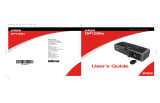
9
Shutting down the projector
The projector automatically blanks the screen after no active source is
detected for 30 minutes. This blank screen helps preserve the life of the pro-
jector. The image returns when an active source is detected or a remote or
keypad button is pressed.
Screen Save
You can make the blank screen appear after five minutes by turning on
Screen Save in the Settings>System menu. See page 24. There are six time
options for the Screen Save feature. They range from five minutes to 30 min-
utes with five minute intervals.
Power Save
The projector also has a Power Save feature that automatically turns the
lamp off after no signal is detected for 20 minutes. After 10 additional min-
utes with no signal, the projector powers down. If an active signal is
received before the projector powers down, the image is displayed. You
must press the Power button to display an image after 30 minutes have
passed. When Power Save is enabled, Screen Save is disabled. See page 24.
Turning off the projector
To turn off the projector, press the Power button and verify that you want to
turn the projector off by pressing the Power button again within 3 seconds.
You can cancel the shutdown by not pressing the Power button a second
time. The lamp turns off and the LED blinks amber for 1 minute while the
fans continue to run to cool the lamp. When the lamp has cooled, the LED
lights amber and the fans stop. Unplug the power cable to completely
power off the projector.
Troubleshooting your setup
If your image appears correctly on the screen, skip to the next section
(page 17). If it does not, troubleshoot the setup.
LEDs
The Lamp LED on top of the projector (page 16) will alert you to certain
problems.
A solid red Lamp LED means it is time to change the lamp. See page 27.
A blinking red Lamp LED means different things based on the number of
“blinks”. After blinking 1-5 times, the light turns off for 2 seconds, then the
blinking repeats.
• 1 blink, lamp won’t turn on: Turn the projector off for at least one
minute, then turn it on again. If the blinking continues, the lamp may
need to be replaced.
• 2 blinks: Remaining lamp life is low. Replace the lamp, see page 27.
• 3 or 4 blinks: Unexpected shut down (3 blinks) or fan failure (4
blinks). Turn the projector off for at least one minute, then turn it on
again. If the blinking continues, the projector may require service; go
to www.infocus.com/support.
• 5 blinks: The projector is overheating. Turn the projector off and
remove anything that may be blocking its air vents. Leave the projec-
tor off for at least one minute to let it cool before turning it on again.
Important: Continuous operation at high temperature may reduce the
lifetime of the lamp and/or projector.
The other LED on top of the projector indicates the normal operating state
of the projector.
• A solid green LED means the projector is on.
• A blinking green LED means the lamp is turning on. A green “blip”
means the projector is in Screen Save or Power Save mode.
• A blinking amber LED means the lamp is either warming up or cool-
ing down to enter standby mode; a solid amber LED means the pro-
jector is in standby mode.




















